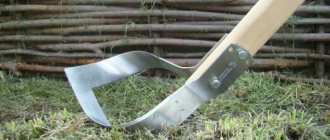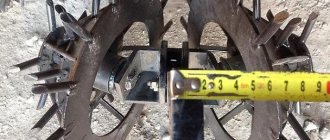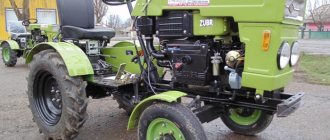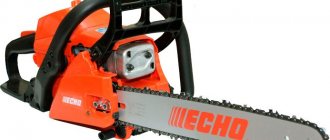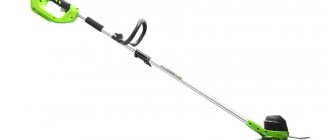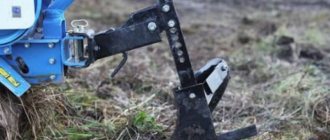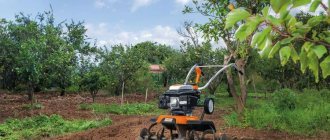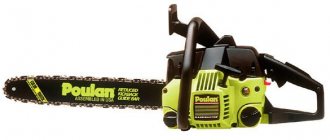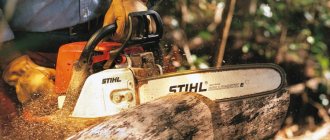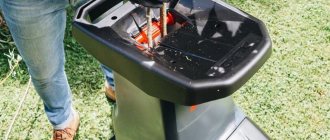That category of summer residents and country property owners who cannot, for one reason or another, purchase motorized equipment, use manual soil cultivation assistants.
This category includes the Strizh cultivator, which in capable hands brings invaluable benefits in caring for your plot. This does not mean that work on processing the top layers of soil will be ineffective and will take a lot of time. As with any other technique, there are specifics to operating a manual assistant. More about this.
Features and purpose
Tool for installing cross-linked polyethylene pipes
The Strizh manual cultivator can replace as many as three agricultural implements: a rake, a hoe and a ripper. This tool is used to loosen the soil and weed beds.
Regular use of a hand cultivator helps prevent soil erosion. For those unfamiliar with this term, let us clarify that erosion is the natural loss of nutrients from soil.
In addition, loosening the soil with a cultivator is called “dry watering.” This procedure helps retain moisture and allows plants to be better saturated with oxygen and ultraviolet radiation, which is the key to a good harvest.
Using the Strizh cultivator you can perform the following types of work:
- Delicate weeding in the beds.
- Loosening the soil using the dumpless method.
- Clearing the garden area of weeds.
- Harrowing small plots of land.
- Almost all types of greenhouse and greenhouse work.
- Formation of furrows for planting small-seeded plants. These include: radishes, cucumbers, tomatoes, dill.
- Caring for the root system of garden trees and shrubs.
Cultivator "Strizh": device, reviews, photos, videos, price
That category of summer residents and country property owners who cannot, for one reason or another, purchase motorized equipment, use manual soil cultivation assistants.
This category includes the Strizh cultivator, which in capable hands brings invaluable benefits in caring for your plot.
This does not mean that work on processing the top layers of soil will be ineffective and will take a lot of time.
As with any other technique, there are specifics to operating a manual assistant. More about this.
The nuances of operating a cultivator
Manufacturers of this equipment have made it possible to use two types of weeder. The hand-held cultivator "Strizh" is available in two sizes:
- Wide – 120 mm.
- Narrow – 65 mm.
Mounted plow PLN 3-35: description, photo, technical characteristics.
Find out how to make a garden shredder with your own hands here.
A few words about knives
The photo of the Swift cultivator , which is posted on the Internet, is equipped with steel knives.
To enhance the quality, the metal is specially hardened in parts of the cutting edge, using advanced processing methods.
This allows you to use the tool for a long time without resorting to sharpening it during soil cultivation operations.
The knife is made in such a way that the surface of the land can be processed in two directions: forward and reverse. This greatly facilitates the process, creating comfortable conditions.
What else can you say about knives? Perhaps we should highlight one important detail: the very small thickness of the knives. Essentially, this is a well-sharpened razor for effective work on the ground.
Since the knives enter the soil more freely, encountering less resistance, working has become more comfortable and faster. Self-sharpening of the knife occurs when performing soil cultivation work.
Due to the mobility of the knife and the sharpened blade on both sides, loosening and cutting layers of earth is more effective. Due to the knife constantly being in the ground, the surface can be processed much faster.
The weeding cultivator "Strizh" will be used more efficiently if you choose the right cuttings. This is an important point for high-quality soil cultivation. The size of the shaft directly affects the work capacity of the summer resident, allowing him to perform work in a comfortable manner.
The swift video cultivator, which is posted on the Internet, provides assistance in:
- loosening the earth using a non-mouldboard method;
- a reliable assistant in the fight against weeds;
- it can be used to carry out harrowing;
- trims plants at a depth of 2 to 6 cm;
- easy to cut furrows for planting dill, lettuce, radishes, tomatoes, cucumbers and other small-seeded crops;
- a reliable assistant in the fight against grass.
Manual precision seed drill: characteristics, method of operation.
Find out the design features and characteristics of a potato digger for a walk-behind tractor here.
Read the article about the Mole walk-behind tractor.
Product price
The price of a flat-cutter cultivator "Strizh" ranges from 300 to 400 rubles. It all depends on the seller and your bargaining ability.
CLAIM
1. A universal manual weeder containing a working body in the form of a plate with pointed edges and a holder for the handle, characterized in that it is made in the form of a quadrangle with a right angle at the apex on the side where the holder is attached and an acute angle formed by equal sides of the plate, with the center The gravity of the plate is located on its plane with the possibility of rotating the plate.
2. Weeder according to claim 1, characterized in that the acute angle formed by equal sides of the plate is 70°.
3. Weeder according to claims 1 and 2, characterized in that the angle of rotation of the plate under the influence of the center of gravity is 20÷30°.
4. Weeder according to claim 1, characterized in that the ratio of the size of the segments formed by perpendiculars from the point defining the center of gravity of the plate to the sides of the right angle must be constant.
5. Weeder according to claim 1, characterized in that the angle of attachment of the holder with the plate plane is 75÷80° with the holder axis.
6. The weeder according to claim 1, characterized in that on the outer side of the plate the blade is sharpened at an angle of 15° with the application of a sawtooth-shaped layer of metal of increased hardness.
7. Weeder according to claim 6, characterized in that a layer of metal of increased hardness is applied with a thickness of 10÷15% depending on the thickness of the blade of the plate.
8. A universal manual weeder containing a working body in the form of a plate with pointed edges and a holder for the handle, characterized in that it is made in the form of a pentagon with an obtuse angle at the apex and one of its sides adjacent to the side of the holder fastening and an acute angle formed by its other side and base of the plate, while the center of gravity of the plate is located on its plane with the possibility of rotating the plate.
9. The weeder according to claim 8, characterized in that the acute angle is 70°.
10. Weeder according to claim 8, characterized in that the other acute angle adjacent to the base is 80÷85°.
11. Weeder according to claims 8 and 9, characterized in that the angle of rotation of the plate under the influence of the center of gravity is 20÷30°.
12. Weeder according to claim 8, characterized in that the ratio of the size of the segments formed by perpendiculars from the point defining the center of gravity of the plate to the sides of an obtuse angle must be constant.
13. Weeder according to claim 8, characterized in that the angle of attachment of the holder with the plate plane is 75÷80° with the holder axis.
14. The weeder according to claim 8, characterized in that on the outer side of the plate the blade is sharpened at an angle of 15° with the application of a sawtooth-shaped layer of metal of increased hardness.
15. Weeder according to claim 14, characterized in that a layer of metal of increased hardness is applied with a thickness of 10÷15% depending on the thickness of the blade of the plate.
Types of flat cutters and their use
Design of a flat cutter.
The design of the tool is designed in such a way that it cuts the soil without moving it. The Fokina and Teplichny flat cutters have an identical structure; the Teplichny one has a thinner tip. Let's take a closer look at the technology of using this tool.
Cutting elements for the Fokin flat cutter are available in two sizes: large and small. All cutting edges of the flat cutter are sharpened, which allows you to work with both right and left hands.
Using the sharpened toe and heel of the blade or the entire cutting part of the flat cutter, soil is loosened, ridges are formed, weeds are removed, and hilling is done.
The flat cutter is fixed on the back side. The cutting and guide planes form an angle of 90⁰.
Rice. 1
1 – “heel”, 2 – “toe”
Loosening the soil.
Loosening the soil to a depth of 15 cm is carried out with a large Fokin flat cutter. The effectiveness of loosening with this flat cutter is obvious on softer soils (sandy, sandy loam, podzolic, etc.). On heavy soils, it is recommended to use flat cutters “Strizh” and “Aist”.
Preparing for work
Connect the cutting element to the handle using a bolt connection, as shown in Fig. 2. The position of the bolted connection is selected depending on height and individual characteristics.
Loosening narrow row spacings
Take the cutting in your hands, as shown in Fig. 3.
Deepen the toe of the blade to the desired depth and move the tool towards you, pressing it to the ground (Fig. 4)
Loosening the soil in open areas.
Take the handle like a regular rake and bury the cutting element with the blade flat into the soil (Fig. 5).
Guide the tool towards you smoothly.
When working on heavy soils, the loosening operation can be done in jerks.
For work in greenhouses, greenhouses, greenhouses, it is recommended to use a flat cutter with a shortened handle.
Formation of ridges.
After preparing the soil for planting, it is necessary to form ridges.
To form a ridge, stand on one side of it and turn the cutting element so that the toe is directed to the side. Deepen the blade into the soil in a flat position and rake the soil on the other side - see fig. for hand position when working. 6
position of the tool during operation, see fig. 7.
As a rule, large clods of earth remain on the surface of the formed ridge, which need to be broken up. In this case, the flat cutter should be positioned flat with its blade parallel to the bed, without deepening it, and worked like a rake.
Grooving.
The choice of cutting element depends on the required furrow depth. The work is carried out similarly to loosening narrow row spacing (see Fig. 2, 3, 4). Move the cutting element over the intended location several times. A groove of the required depth will remain on the surface (see Fig. 8).
Hilling up plants.
Take the cutting in your hands like a rake (see Fig. 9)
and turn the cutting element so that the toe of the blade is directed to the side. Push the blade flat into the soil and work like a hoe (see Fig. 10).
As a result, the soil will be raked towards the plant stem.
Hilling can be done with the heel of a flat cutter, making intermittent movements.
To perform a large amount of work in a short time on heavy soils, it is advisable to use other types of flat cutters (“Swift”, “Stork”, “Pyshka”).
Removing weeds.
When removing young weeds, work with a flat cutter is performed in the same way as loosening the soil in open areas (see Fig. 2, 3, 5).
Trim weeds with intermittent movements. To trim large weeds, bury the tool into the soil (see Fig. 11)
and cut the weed with intermittent movements at a depth of up to 5 cm (see Fig. 12).
FLAT CUTTER "Dumpling" (BIG AND SMALL) FROM STAINLESS STEEL
These flat cutters have an improved design - longitudinal bending of the working part. This allows you not only to loosen the soil, but also to remove weeds in the top layer of soil.
Flat cutters are made of stainless steel - a material that is easy to sharpen and resistant to corrosion. The basic working techniques are the same as when working with a Fokin flat cutter.
To change the position of the cutting element relative to the handle, additional holes are made on the cutting elements (Fig. 13, 14).
Pyshka flat cutters are recommended for use on heavy soils.
Specifications
The Strizh cultivator is available in three modifications. The main difference is the width of the work element. This makes it possible to select the optimal model for specific work.
According to the width of the blade, “Swifts” are classified as follows:
- Narrow. Blade width 65 mm.
- Average. The size of the working element is 90 mm.
- Wide. The width of the cutting edge is 120-150 mm.
The choice of cutting edge width directly depends on the planting density of crops. If the plants are at a sufficient distance, it is recommended to use wide and medium models.
When planting density is high, the beds are cultivated with a cultivator with a narrow cutting edge. Considering the low cost of the product, you can purchase two versions of a manual cultivator, which will significantly expand the range of work.
The main element of a hand cultivator is the cutting edge, so it is necessary to describe this part in more detail.
To increase wear resistance, a combination of soft and hard layers of metal is used. The average lifespan of a knife is about seven years. The use of self-sharpening technology does not exclude sharpening the edge of the tool manually if necessary.
The thickness of the cutting edge resembles a razor. Thin but durable metal makes tillage more comfortable and significantly speeds up the work process. Compared to conventional garden tools, Strizh cultivators speed up work by about two times.
Of course, this is not an indicator for mechanical units with an internal combustion engine, but the result is still impressive. In addition, the cost of manual models is an order of magnitude lower than the cheapest mechanical cultivator.
Please note that the frame with the blade is floating, while the knife itself is double-edged. This design makes it possible to operate the cultivator in two directions: forward and reverse.
Taking these features into account, we can say with confidence that Strizh cultivators are indispensable assistants in dacha farming.
Simple design, easy storage and no special maintenance. Here are the main advantages when choosing this tool. Disadvantages include limited functionality.
TELL YOUR FRIENDS
About the manufacturer
But there are other types of equipment on sale that belong to the class of hand cultivators. They are much cheaper than motorized units, such as: Mole, Tarpan, Loplosh, Patriot, Champion, Texas, Viking, which justifies the choice in their favor.
The Swift cultivator is a fairly simple and uncomplicated device in its design. As for the manufacturer itself, this company began its activities in 1992, manufacturing and selling various gardening tools.
The main feature of this product is that the edge of these tools is made in such a way that it remains sharp for a very long time, or sharpens itself during its use. Clearly visible in the photo:
Swift
Only high-quality steel is used in production, so all tools are of exceptionally high quality and reliability. The company's assortment includes various products, which can be divided into two categories:
- Gardening tools.
- Tools for removing ice and snow.
The first category includes various hoes, shovels, weeders, root removers, flat cutters, etc. To remove snow and ice, the company's specialists manufactured various scrapers and sharply sharpened ice picks.
Over its history, the company's products have gained popularity not only in our country, but also in countries near and far abroad.
For more information about the Swift cultivator, watch the video:
Typical flat cutter or Fokina weeder
Many held in their hands a tool for cutting soil and weed roots, shaped like a poker - a flat cutter with a sharply sharpened knife located at an angle to the handle. And few people know that all models with a similar shape are analogues, while the original is the weeder of engineer Fokin. Limited capacity after a heart attack prompted him to develop for himself the most convenient and effective instrument, capable of performing many different operations.
Engineer Fokin's Pololnik
In particular, a flat knife with two sharp edges, located at an angle to the handle, allows you to cut plants like a scythe. In this case, the base of the cutting part of the Fokin flat cutter, curved downward in an arc, easily bites into the ground, leaving behind a loosened groove. Actually, the tool has 3 sharp edges, one of them falls on another edge of the plate, the end edge, farthest from the handle. Slightly beveled, it can easily go into the ground if the tool is used as a narrow hoe. You can see Fokina's weeder in more detail in the photo.
Flat knife with two sharp edges
Thus, you can work with the tool in 3 positions - horizontally to the ground, cutting a thin layer of soil, with a blade located at an angle to the ground, for scraping and cutting weeds, and perpendicularly, instead of a hoe. And this is in addition to various intermediate functions that can be performed by certain areas of the working surface. But the tool also has disadvantages - it is difficult to work with the Fokin flat cutter in narrow rows and under the films of greenhouses, as well as in small spaces between plants.
Weeder Strizh - features of working with a garden tool + Photo, video
First of all, let's determine whether you often need a weeder with a narrow and sharp working edge when processing a site.
It would seem that any work can be done with a trapezoidal hoe of medium width, with a short metal plane. Turn it sideways - and the corner is already biting into the ground with its “beak”, and where necessary, you can go through with the entire blade.
But no, in narrow row-spacings it is very easy for such a tool to disrupt the integrity of the ridges in which the plant roots are hidden.
And even under the leaves of garden crops you can’t see where the wide knife of a hoe will go, so you can cut the stem by accident. And narrow beds are increasingly appearing on the plots of those landowners who are familiar with the Mittleider method.
[/su_box]
Narrow beds using the Mittleider method
Today, the method of using narrow beds and wide spaces between them is considered one of the most advanced, as it ensures high yields.
How to dig
If the farm already has a motor cultivator, then that’s great. But if you can’t purchase it, it doesn’t matter. Two years ago I bought the advertised “Plowman Miracle Shovel” and have never regretted it. My “Miracle Shovel” is 35 cm wide and weighs about 5 kg. It also happens to be 43 cm wide, but it seemed a bit heavy to me. Advantages: the weeds are pulled out completely, all that remains is to collect them, for example, with a fan rake; the soil after processing becomes like fluff, since the shovel also loosens it at the same time; Well, the most important thing is that there is no strain on the back. Disadvantages: somewhat bulky when carrying and storing; It will not dig up virgin soil, only previously cultivated soil.
Fig. 1 It’s better to buy a longer handle for the “Miracle Shovel “Plowman” and you can do it without the handle like in the picture
In 2006, a Vyatka monk developed the “Vyatka Plowman” shovel for uncultivated soils. It is good not only for digging up virgin soil, but also for planting potatoes - due to the fact that the soil is dumped to the side, filling up the planting potatoes thrown into the hole without any extra effort. The weight is the same as that of the “Miracle Shovel” - about 5 kg, the height is adjustable. I haven’t purchased the “Vyatka Plowman” yet, but I don’t need to, I have almost no uncultivated soil.
Fig. 2 On the Internet you can find videos about both the “Miracle Shovel” and the “Vyatka Plowman”. They claim that their productivity is several times higher than the efficiency of a conventional bayonet shovel.
I also have a manual rotary cultivator, bought in a fit of incipient dacha fanaticism. Then modern hand cultivators had just begun to appear, and I really wanted something new. The tool turned out to be very inconvenient: weeds get wrapped around the wheels, which then take a long time and tediously to clean; bulky to store; The nut on the cutter kept falling off, so I had to figure out how to secure it. Such a cultivator is only suitable for quickly weeding a bed that was carefully prepared a week or two ago, but for some reason was not immediately sown and therefore slightly overgrown with young weeds. In general, “everything is complicated...” (c).
Fig.3 The staple is not self-sharpening, you have to sharpen it once a month
How to weed
I don’t know exactly when Fokin invented his famous flat cutter, but in 2007 my mother already had one, and right away with the “correct” handle - not round, but rectangular in cross-section. I got my own dacha in 2008, and since then not a single weeding or planting has been done without this tool. And organic farming, which is fashionable today, generally only recognizes surface tillage of the soil - no more than 5 cm deep.
Fig.4 Fokina flat cutter can be large and small
The “Strizh” cultivator, also known as the “Swinging weeder”, also allows you to minimize the time spent on weeding and loosening. Its action is similar to a potato peeler. True, it also requires sharpening, and a competent one at that. The bracket attached to the end is sharpened on both sides, so you can work with the tool both towards you and away from you. With this weeder I weed and at the same time loosen a bed of strawberries measuring 8m x 1.3m in 10-15 minutes. The advantage compared to the Fokin flat cutter: with such a bracket you won’t miss and you won’t accidentally cut the crop being processed. Disadvantage: some weeds that reproduce by root shoots (for example, rapeseed) grow greatly because they are cut underground and not pulled out, as after the “Plowman” Miracle Shovel.
Fig.5 "Swift" is usually sold without a cutting
Weeder named after Mittleider and its feathered analogue
With such a system for growing garden crops, it is impossible to do without a weed weed, and therefore Jacob Mittleider developed a special weed weed in the shape of a bracket. Having 2 cutting edges, it is capable of biting into the ground with both of them during forward and backward movement of the tool. Thus, this weeder, named after Mittleider, is capable of weeding a fairly wide strip with just 2 passes, cutting off weeds at the point of their growth or cutting off the roots at a depth of 1-2 centimeters. However, the design, which resembles a stirrup, that is, closed on both sides of the cutting edge by arched rods attached to the handle, does not allow the fight against large weeds. This is where weeder Strizh comes to the rescue.
Weeder "Strizh" for the vegetable garden
He has a very indirect relationship with the bird of the same name. Several models of flat cutters are produced under this brand, the usual frame Mitlider and a leaf-shaped one, with an elongated loop of the working blade, a contour reminiscent of a curved beak. They can cut plants, making a lateral movement like a hockey stick, while the lower knife plunges into the ground, and the upper one simply cuts the stems. There are many different photos of this instrument. There is also a model that is very reminiscent of a frame, with two arched holders, which at the same time has the shape not of a stirrup, but of a slightly curved heart. All these bends allow you to work even with thick stems.
